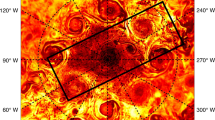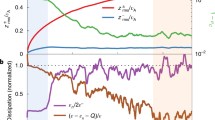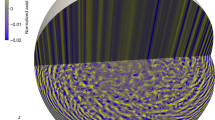Abstract
The heat budget of the region of the upper atmosphere near the mesopause at ∼85 km is determined by a balance between radiative, photochemical and dynamical effects leading to a very cold polar mesopause in the summer and a comparatively warm mesopause in the winter. There is a temperature minimum at the mesopause primarily because of the strong radiative cooling which occurs due to thermal emission by carbon dioxide in its v2 vibrational band at 15 µm wavelength. Above 80 km this band is no longer in local thermodynamic equilibrium (LTE) so the amount of cooling depends critically on the rate at which CO2 molecules are excited or relaxed by collision. Any estimate of radiative cooling for this region of the atmosphere, therefore, relies on knowledge of the collisional relaxation time, τ. The importance of the temperature dependence of τ was pointed out by Houghton1. Previous calculations used a wide range of values because no direct measurements of τ had been made in the appropriate temperature range. We show here that the effect on cooling rate calculations of using values of τ measured at temperatures down to 175 K. We also estimate a radiative relaxation time for the atmosphere near the mesopause and are able to draw conclusions as to the natural lifetime of any temperature perturbation at this altitude.
This is a preview of subscription content, access via your institution
Access options
Subscribe to this journal
Receive 51 print issues and online access
$199.00 per year
only $3.90 per issue
Buy this article
- Purchase on Springer Link
- Instant access to full article PDF
Prices may be subject to local taxes which are calculated during checkout
Similar content being viewed by others
References
Houghton, J. T. Q. Jl R. met. Soc. 95, 1–20 (1969).
Drayson, S. R. Univ. Michigan, Coll. Engng. Tech. Rep., 07584-1-T (1967).
Kondratyev, K. Y., Badinov, I. Y., Gaevskaya, G. N., Nikolsky, G. A. & Shved, G. M. Problems of Atmospheric Circulation (Spartan, New York, 1965).
Williams, A. P. thesis, Univ. Oxford (1971).
Taylor, R. L. & Bitterman, S. Rev. mod. Phys. 41, 26–47 (1969).
Allen, D. C., Price, T. J. & Simpson, C. J. S. M. Chem. phys. Lett. 45, 183–187 (1977).
Simpson, C. J. S. M., Gait, P. D. & Simmie, J. M. Chem. phys. Lett. 47, 133–136 (1977).
Allen, D. C. thesis, Univ. Oxford (1979).
Houghton, J. T. The Physics of Atmospheres (Cambridge University Press, 1977).
Offermann, D. et al. J. atmos. terr. Phys. 41 (in the press).
Author information
Authors and Affiliations
Rights and permissions
About this article
Cite this article
Allen, D., Haigh, J., Houghton, J. et al. Radiative cooling near the mesopause. Nature 281, 660–661 (1979). https://doi.org/10.1038/281660a0
Received:
Accepted:
Issue Date:
DOI: https://doi.org/10.1038/281660a0
This article is cited by
-
An investigation of the dependence of structural parameters of the middle atmosphere on the intensity of photochemical and dynamical processes
Pure and Applied Geophysics PAGEOPH (1988)
Comments
By submitting a comment you agree to abide by our Terms and Community Guidelines. If you find something abusive or that does not comply with our terms or guidelines please flag it as inappropriate.



